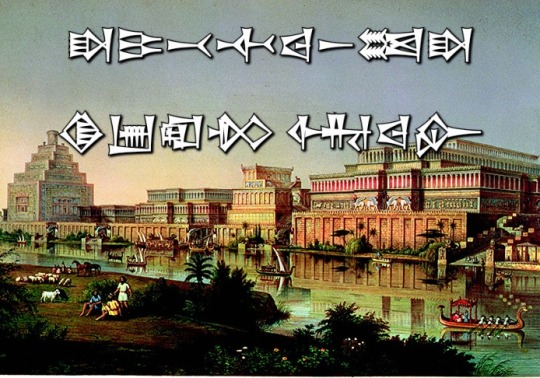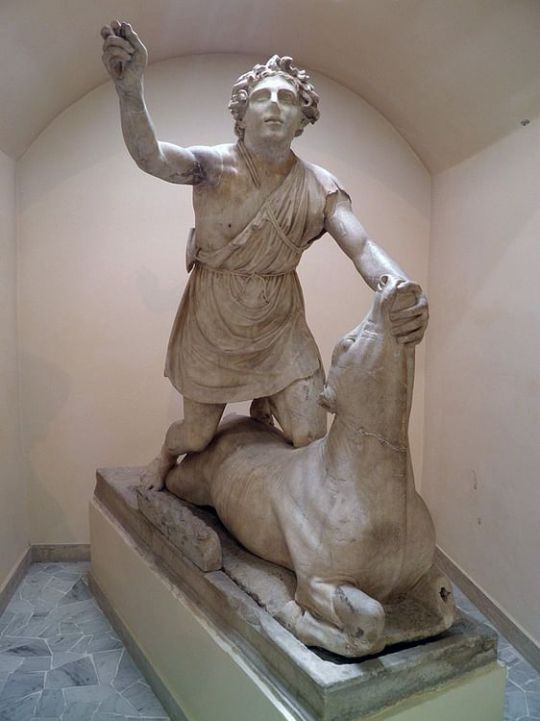#akkadian empire
Text

Line drawing of an impression from the cylinder seal of Shar-Kali-Sharri, ruler of the Akkadian Empire ca. 2217-2193 BCE. On the right of the impression, the hero Gilgamesh wrestles with a lion. From The Seal Cylinders of Western Asia by William Hayes Ward, published in 1910.
#art#art history#ancient art#Ancient Near East#Mesopotamia#history#ancient history#Akkadian#Akkadian Empire#Shar-Kali-Sharri#cylinder seal#cuneiform#Gilgamesh
48 notes
·
View notes
Text

Founder of the world’s first empire, Sargon of Akkad upheld order and justice. Photograph by Dea Picture Library, De Agostini/Getty.
Learn more / Daha fazlası
Sargon https://www.archaeologs.com/w/sargon/
#archaeologs#archaeology#archaeological#dictionary#history#mesopotamia#akkadian#akkadian empire#sargon#agade#syria#anatolia#elam#emperor#arkeoloji#tarih#sanat#anadolu#mezopotamya#suriye#akkad imparatorluğu
184 notes
·
View notes
Text
ROUND 1: SARGON (first ruler of the akkadian empire) VS WAMBUS TROUBLEHAM (bugsnax)


#tournament#now kill#f1#bugsnax#wambus#wambus troubleham#sargon#sargon of akkad#akkadian empire#mesopotamia
220 notes
·
View notes
Text
Ancient Mesopotamia was the birthplace of some of history’s greatest empires. All of them had to contend with the mysterious Gutians, a nomadic nation of deadly raiders.
16 notes
·
View notes
Link
59 notes
·
View notes
Text
I can't believe I'm finding out at noon on a Saturday in my mid-30s, via a YouTube video that quickly moved onto other points, decades into my fascination with history, that the location of the city of Akkad is unknown.
3 notes
·
View notes
Text

The ancient city of Babylon, the "southern region" of the bronze age world, with a cuneiform inscription reading "Southern Price Worldwide" in Akkadian (ša-imitti baštu ki-ibradim arbaim)
#Mesopotamia#bronze age#Akkad#akkadian empire#Babylon#babylonia#naram-sin#southern pride worldwide#history#history meme
9 notes
·
View notes
Text
Sumer was the southernmost region of ancient Mesopotamia (modern-day Iraq and Kuwait) which is generally considered the cradle of civilization. The name comes from Akkadian, the language of the north of Mesopotamia, and means “land of the civilized kings”. The Sumerians called themselves “the black headed people” and their land, in cuneiform script, was simply “the land” or “the land of the black headed people”and, in the biblical Book of Genesis, Sumer is known as Shinar.
According to the Sumerian King List, when the gods first gave human beings the gifts necessary for cultivating society, they did so by establishing the city of Eridu in the region of Sumer. While the Sumerian city of Uruk is held to be the oldest city in the world, the ancient Mesopotamians believed that it was Eridu and that it was here that order was established and civilization began.
1 note
·
View note
Text

The coronation of the king of Assyria by the gods
The Assyrian king receives the insignia of power from the gods Aššur (Ashur) and Ištar (Ishtar).
Ashur is in front of the Assyrian king and Ishtar is behind him and puts the king's hat on the king's head.
Read More:
What does ashurbanipal name mean (Video)
What does ashurbanipal name mean (Text Post)
How does Ashurbanipal introduce himself (Text Post)
Follow my YouTube channel. Silent tablets documentary, short videos from ancient history.
Follow my Twitter.
Source:
Oracc
#archaeology#ancient mesopotamia#mesopotamia#ancient history#akkadian#ancient iraq#ancient assyria#assyrian#ancient empire#ancient assyrian king#history of mesopotamian kings#history of ancient assyrfia#god of ashur#god of ishtar#gods of mesopotamia
7 notes
·
View notes
Text
(List) Mother of Monsters: The Eleven Children of Tiamat - Historic Mysteries
https://www.historicmysteries.com/tiamat-monsters/
View On WordPress
#1500 BC#9th century BC#Akkadian#Amulets#Babylon#Dagon#Epic of Gilgamesh#Hydra#Kumugi#Kusarikku#Mesopotamia#Minotaur#Persian Empire#Shamash#Tiamat
2 notes
·
View notes
Text
Nineveh was Jacksonville, Florida
Nineveh was Jacksonville, Florida
Nineveh was Jacksonville, Florida was first reveled to me by Neophyte Dag on YouTube from his video, entitled, “The Black Messiah Prince Lewis and the Black 144,000 Saints Elect part 3: https://www.youtube.com/watch?v=nWWxZaQAe6g.
The above video shows you map comparisons of the State of Florida to Assyria and Babylon. In this post is the same map comparison for your own viewing convenience. As…

View On WordPress
#Abyssinia#Acadia#Acadians#advanced ancient civilization#advanced ancient technology#Advanced Technology#Akkad#Akkadians#Amurru#Ancient Egypt#Ancient Mesopotamia#Ancient Turkey#Assyria#Assyrian Empire#Babylon#Ethiopia Superior#Euphrates River#free energy#Gulf of Mexico#History of Jacksonville#India Superior#Kush#La floridas#La Louisiana#Map of Carolana#Mediterranean Sea#Mississippi Mound Builders#Mississippi River#Moors#Nile River
4 notes
·
View notes
Text
youtube
The Tower of Babel (2233 BC) Ambient Music
#the tower of babel#babel an arcane history#library of babel#babel#babylonian#myth#myths#myths and legends#yahweh#babylon#marduk#sumerian#mesopotamia#akkadian#sumerian mythology#gilgamesh#assyrian#ancient empires#ancient history#ancient city#ancient civilizations#lost city#babel tower#torre de babel#Youtube
1 note
·
View note
Text
Conlanging Issues: A Compendium
NOTE: This question was submitted before the Nov 1, 2023 reopening and may not adhere to all rules and guidelines. The ask has been abridged for clarity.
Most of my questions are about linguistics. […] One of the major locations in my story is a massive empire with cultural inspirations ranging from North Africa in the far south to Mongolia/Russia in the far north […] The middle region is where the capital is and is the main root of culture, from which Ive been taking inspiration from Southwest Asia […], but most notably southern regions of India. I've tried to stick to the way cities are named in Sanskrit-based languages but added the names of stars to the front (because the prevalent religion of this region worships the stars [...]). So Ive ended up with names like Pavoprayag, Alyanaga, Alkaiduru, Alcorpura, Cygnapete, etc. Is this a consistent naming system or should I alter it in some way? The empire itself is named the Arcana Empire since [...] each act of my story is named after a tarot card [...].
Another region in my story is based more on parts of South China and North Vietnam, so I've tried to stick to names with a Chinese origin for that. I understand the significance of family names in southwest [sic] Asia, so I wanted to double check [...]. They have only two short given names. Based on the birth order of the child, the first half of the name comes from the fathers family and the second half from the mothers family. It is seen as disrespectful not to use both names because using only one is seen as denouncing that side of your family. Thus I have names like Su Yin, Dai Jun, and Yi Wen for some of the characters from this region, and the city itself that they are from is named Bei Fen.
On the other hand, Im having further trouble naming characters. […] Ive been trying to give my human characters names from real human cultures to distinguish them from the website-generated names of say, orcs, elves, dwarves, etc, but I think I should change many of the names Ive used to be more original and avoid fracturing real world cultures for the sake of my worldbuilding. […] Im still very weak in the linguistics area (even after four years of French, sigh) and am having trouble finding where to read about naming patterns so I can make new ones up. I read your naming guides but am still having trouble on where to start for specific languages. […] Im trying to look into Sanskrit, Turkish, and Persian specifically.
You're Going Too Broad
In my opinion, you’re casting too wide a net. You mentioned looking into Sanskrit, Turkish, and Persian to develop fantasy names. These languages are very different from one another, so unless you’re using them separately for very different parts of your world, it will be hard to draw inspiration from them in a way that makes sense. You’re taking on a huge amount of research in order to worldbuild cultures that span a massive geographical area (basically all of North Africa and Asia?) and have very little in common. Are you sure you want to take on that task?
I could see it being more manageable if most of your story is set in a small region of this world, which you will then research in depth to make sure you’re being as specific as possible.
Taking Persian as an example, you’ll have to decide whether you want to use Old Persian, Middle Persian, or Modern Persian. Each of these comes with a different alphabet and historical influences. They’re also associated with different periods of time and corresponding cultural and social markers. Once you’ve decided exactly when and where you want to start from, you can then expand the borders of your area of focus. For example, if you’ve decided to draw inspiration from Achaemenid Persia, you can then look at the languages that were spoken in the Achaemenid Empire. A quick Google search tells me that while Old Persian was the empire’s official language, they also used Aramaic, Akkadian, Median, Greek, and Elamite (among, I’m sure, many many others and many more regional variations). Further research into each of these will give you ethnic groups and bordering nations that you can draw more inspiration from to expand out your worldbuilding.
Don’t forget to make sure you’re staying within the same time period in order to keep things consistent. It’s a lot of work, and this is only for a small portion of the continent-spanning worldbuilding you’re trying to do.
You can get away with painting the rest of the continent in broad strokes without too much depth if the story doesn’t go there and you don’t have any main characters from those parts of the world. Otherwise, you’ll need to put this same level of detail into your worldbuilding for the area with Turkish-inspired names, and again for the area with Sanskrit-inspired names, and so on.
I know this isn’t what you were asking, but I honestly have a hard time helping you figure out where to start because your ask is so broad I don’t quite know where I would start myself. So, this is my advice: focus down on one region and time period and go from there. Feel free to write back once you’ve picked a narrower focus that we could help you with.
- Niki
So there’s logistical issues in regards to your naming system for southern China-coded regions. One issue is history: mainly on how there is not simply one language in China but multiple due to having a lot of ethnic groups and the size of China. South China in particular has different dialects and languages than the North as seen in this map of Chinese languages and dialects. There’s also how historically Mandarin was not the official language until 1913 in China and historical China saw vast changes in territory dependent on the dynasty. Before then, Mandarin was primarily a northern Chinese language based in Beijing while southern China had its own languages, dialects, and dynamics. Not to mention, historical China saw an evolution of language just like English has Old English, Middle English, Early Modern English, and Modern English. For instance, Vietnam was once part of China during the Tang Dynasty and at another point, it was not part of China.
-Mod Sci
If You’re Borrowing Whole Words or Elements, Research More
The other issue is inconsistency with the cultures you’re deriving this conlang from. In regards to “two given names,” the Chinese name I was given was one syllable and then I would have a last name that was also one syllable. There’s also how not every family is perfect. Not every marriage is sanctioned and some children may come from single parents. Some families may not cooperate with marriage and sometimes children may be abandoned with unknown parents. There does not seem to be contingencies for these names under this conlang system.
The main problem with conlangs is that one needs to truly understand the languages one is drawing from. Tolkein managed to create conlangs due to training in linguistics. Mandarin is already a difficult language with multiple tones, and trying to use it for conlangs without knowledge of how Mandarin works or a good foundation in linguistics is just a Sisyphean endeavor.
-Mod Sci
Four years of French wouldn’t have taught you about linguistics as a science or anything about the language families you’ve listed - Indo-Iranian, Sino-Tibetan, and Turkic, nor any Asian naming conventions. I agree with Niki that you need to narrow down your research.
Pur/pura means city in Sanskrit (ex: Gurdaspur, Hoshiarpur). Prayag is a place where pilgrimages are done. Naga isn’t a place name in Sanskrit (google says it means snake), nagar is and it means town. X Nagar is a very common name for places (Ex: Rajinder Nagar). Many cities in Karnataka have names ending in uru (Bengaluru, Mysuru, Mangaluru, Tumakuru, etc) but the language of Karnataka is Kannada - a Dravidian language and completely different family from Sanskrit (Indo-Aryan). I’m not sure where “pete” came from. “Bad” and “vaal” are common suffixes for places too (Ex: Faisalabad, Allahabad). A disclaimer that I do not speak Sanskrit, I speak Punjabi, which is a descendant of Sanskrit and in the same linguistic family (Indo-Aryan languages).
- SK
Also, This Is Not…Really Conlanging.
Hi OP. Linguistics refers to the science of studying how languages work, not the discipline of learning languages. And nothing shows that gap more than how you have thus far approached constructing fictional languages and toponyms.
The reason why Sci and SK have a lot to say about your place names is because they don't resonate—you have borrowed whole words into your toponyms (place names) from a variety of languages—without an accurate understanding of what these words mean, how they’re pronounced, where they’re derived from—and expected them to work together. I suggest you read the links below on why conlanging is not as simple as choosing some languages and mashing their IRL words together:
Why Using Random Languages Wholesale in your Fantasy is a Bad Idea
Pitfalls of Mashing Countries and Languages in Coding
In your city names, for example, you’re using star names from multiple languages that use different sets of sounds represented by different sets of historical spelling rules. “Cygn-” and “Arcana” stick out like a sore thumb—the fact that one “c” is /s/ and one is /k/ is an obvious flag that they are Latin-derived English borrowings. This is because spelling rules were created in Middle English to make sense of the mix of “c” pronunciations across words of Indo-European origin due to a historical split called the Centum-Satem division. This is a phenomenon that is very specific to our world history, and to the history of English at that. Ironically, in your attempt to avoid stock fantasy names (which also often fall into the Latin-derived English pit), you are taking the exact same approach to naming.
Like Niki said, your selections are far too broad to code under a single umbrella. Do you expect that whatever language that city name came from runs the full gamut of sound inventory & spelling variety that spans multiple continents and hundreds of languages? Because that’s not how languages work. (And yes, I mean hundreds. Indigenous languages and linguistic diversity are a thing. See Niki’s note about just the languages in Persia. And nation-states bulldozing over those languages and pretending it’s just one language is a thing. See Sci’s note about China.) I haven't even talked about the variation in morphology (how words are formed) or syntax (sentence structure).
Please just read or re-read my guide on “naming conlangs” in this post and start from there.
~ Rina
PSA ON CONLANGING AND FANTASY NAMES:
For fantasy language asks submitted after Nov 1, 2023, the asker must indicate that they have read Mod Rina’s conlanging posts linked in FAQ 2 (Guides and Posts by Topic) of the Masterpost under the question “How do I make a fictional language for my story?” While this is an older ask, we are posting it as an example to our followers.
Per our new rules, any questions that can be directly answered in or extrapolated from the FAQs, or questions that indicate that the relevant resources haven’t been read, will be deleted with a note in the Deletion Log explaining why.
As always, if this post was helpful or educational to you, please consider tipping the relevant mods: SK, Niki, Sci, and Rina.
Edited for terminology errors
319 notes
·
View notes
Text
Akkadian cylinder seals weren’t just a way to guard storage jars from people with sticky fingers. Each one was unique, serving as an early form of the owner’s signature.
14 notes
·
View notes
Photo

Mithraism
The Mithraic Mysteries, also known as Mithraism, were a mystery cult in the Roman world where followers worshipped the Indo-Iranian deity Mithras (Akkadian for "contract") as the god of friendship, contract and order. The cult first appeared in the late 1st century CE and, at an extraordinary pace, spread from the Italian Peninsula and border regions across the whole of the Roman empire.
Learn more about Mithraism
313 notes
·
View notes
Text
Shoutout to the guy writing the sumerian king list, who says of the period just after the fall of the Akkadian empire "Who is King? Who is not King?"
Historians and archaeologists for all eternity feel your pain
#ancient history#memes#tagamemnon#ancient history memes#mesopotamia#ancient sumeria#akkadian#bronze age
80 notes
·
View notes